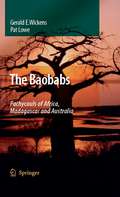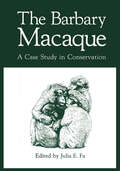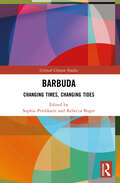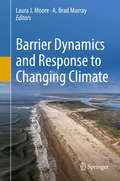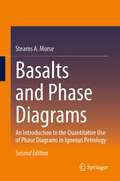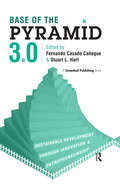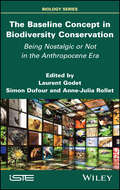- Table View
- List View
The Baobabs: Pachycauls of Africa, Madagascar and Australia
by G.E. WickensThis is the only comprehensive account of all eight species in the genus Adansonia. It describes the historical background from the late Roman period to the present. It covers the extraordinary variety of economic uses of baobabs. There are also appendices on vernacular names, gazetteer, economics, nutrition and forest mensuration. This book fills a gap in the botanical literature. It deals with a genus that has fascinated and intrigued scientists and lay persons for centuries.
The Barbary Macaque: A Case Study in Conservation (Contributions To Primatology Ser. #Vol. 23)
by John E. FaThe Barbary macaque (all too often mistakenly called an ape) was first brought to the attention of the Conservation Working Party of the Primate Society of Great Britain late 1979 when John Fa reported that 'surplus' animals were being sent from Gibraltar to dubious locations, such as an Italian safari park. Since there had been no scientific input into the Army's management of the monkey colony on Gibraltar, and there was concern about inbreeding, nutrition and health - about the long-term viability of the colony, it was felt that the Society could help. The Gibraltar Scientific Authority and the Army were very receptive to our offer and ideas, and this topic occupied successive chairmen over the last few years - Robin Dunbar and Richard Wrangham, myself and now Miranda Stevenson - with constant prompting and help from John Fa. Considerations soon extended to the status of the species as a whole, so that there have been three main aspects:- (1) the improved health of a larger self-sustaining population on Gibraltar, (2) the status and behavioural biology of natural populations in North Africa (Morocco and Algeria), and (3) the breeding achievements in European parks and zoos, and their potential for reintroduction to suitable areas in North Africa, along with other possibilities. Robin Dunbar organized the compilation of recommendations for managing the Gibraltar colony with regard to numbers, age-sex struc ture and behavioural relationships, with some observations on diet to avoid obesity and infertility.
Barbuda: Changing Times, Changing Tides (Critical Climate Studies)
by Sophia Perdikaris Rebecca BogerThis volume explores a range of themes including impacts of climate change, resilience, sustainability, indigeneity, cultural genocide, disaster capitalism, preservation of biodiversity, and environmental degradation. Focusing on the island of Barbuda in the West Indies, it shares critical insights into how climate change is reshaping our world. The book examines how climate has changed in the Caribbean over different spatial and temporal scales and how varying natural and anthropogenic factors have shaped Barbuda’s climatic and cultural history. It highlights projections of 21st-century climate change for the Caribbean region and its likely impacts on Barbuda’s coastal ecosystems, potable groundwater resources, and heritage. With essays by researchers from the United States, Canada, Caribbean, and Europe, this volume straddles a range of disciplines such as archaeology, anthropology, paleoclimatology, environmental sciences, science education, and Traditional Ecological Knowledge (TEK). Drawing on interdisciplinary and transdisciplinary approaches that explore the intersection of natural and social systems over the longue durée, the volume will be of interest to scholars, researchers, and students of ethnography, social anthropology, climate action, development studies, public policy, and climate change.
Barbuda: Changing Times, Changing Tides (Critical Climate Studies)
by Sophia Perdikaris and Rebecca BogerThis volume explores a range of themes including impacts of climate change, resilience, sustainability, indigeneity, cultural genocide, disaster capitalism, preservation of biodiversity, and environmental degradation. Focusing on the island of Barbuda in the West Indies, it shares critical insights into how climate change is reshaping our world. The book examines how climate has changed in the Caribbean over different spatial and temporal scales and how varying natural and anthropogenic factors have shaped Barbuda’s climatic and cultural history. It highlights projections of 21st-century climate change for the Caribbean region and its likely impacts on Barbuda’s coastal ecosystems, potable groundwater resources, and heritage. With essays by researchers from the United States, Canada, Caribbean, and Europe, this volume straddles a range of disciplines such as archaeology, anthropology, paleoclimatology, environmental sciences, science education, and Traditional Ecological Knowledge (TEK). Drawing on interdisciplinary and transdisciplinary approaches that explore the intersection of natural and social systems over the longue durée, the volume will be of interest to scholars, researchers, and students of ethnography, social anthropology, climate action, development studies, public policy, and climate change.
Barite-Fluorite Mineralization in Southeast Sichuan, Yangtze Block, China (Modern Approaches in Solid Earth Sciences #23)
by Hao Zou Shou-Ting Zhang Min Li Zhan-Zhang XuThis book describes the mineralization process of barite-fluorite deposits in southeastern Sichuan, Yangtze Block, China. Mainly through systematic field geological surveys and detailed indoor research work, the typical barite-fluorite deposits in this area were analyzed using a variety of analysis methods such as single fluid inclusion LA-ICP-MS composition analysis, trace rare earth element analysis, H-O-S-Sr isotope analysis, F element content analysis, and Sm-Nd geochronological analysis. By in-depth analysis of the ore-forming environment, mineralization process and geological characteristics of barite-fluorite deposits, the following were determined: (1) the source of ore-forming fluids of barite-fluorite deposits and (2) the migration, concentration, enrichment, and evolution of ore-forming sources, exploring the formation mechanism of barite-fluorite deposits. Summarizing the mineralization regularity of the deposit in this area of China provides a new insight and basis for the study of similar types of deposits in the world.
Barley: Production, Improvement, and Uses (World Agriculture Series #11)
by Steven E. UllrichBarley is one of the world's most important crops with uses ranging from food and feed production, malting and brewing to its use as a model organism in molecular research. The demand and uses of barley continue to grow and there is a need for an up-to-date comprehensive reference that looks at all aspects of the barley crop from taxonomy and morphology through to end use. Barley will fill this increasing void. Barley will stand as a must have reference for anyone researching, growing, or utilizing this important crop.
Barley: Production, Improvement, and Uses (World Agriculture Series #12)
by Steven E. UllrichBarley is one of the world's most important crops with uses ranging from food and feed production, malting and brewing to its use as a model organism in molecular research. The demand and uses of barley continue to grow and there is a need for an up-to-date comprehensive reference that looks at all aspects of the barley crop from taxonomy and morphology through to end use. Barley will fill this increasing void. Barley will stand as a must have reference for anyone researching, growing, or utilizing this important crop.
Barrier Dynamics and Response to Changing Climate
by Laura J. Moore A. Brad MurrayThis book presents chapters, written by leading coastal scientists, which collectively depict the current understanding of the processes that shape barrier islands and barrier spits, with an emphasis on the response of these landforms to changing conditions. A majority of the world’s population lives along the coast at the dynamic intersection between terrestrial and marine ecosystems and landscapes. As narrow, low-lying landforms, barriers are especially vulnerable to changes in sea level, storminess, the geographic distribution of grass species, and the rate of sand supply—some barriers will undergo rapid changes in state (e.g., from landward migrating to disintegrating), on human time scales. Attempts by humans to prevent change can hasten the loss of these landforms, threatening their continued existence as well as the recreational, financial and ecosystem service benefits they provide. Understanding the processes and interactions that drive landscape response to climate change and human actions is essential to adaptation. As managers and governments struggle to plan for the future along low-lying coasts worldwide, and scientists conduct research that provides useful guidance, this volume offers a much-needed compilation for these groups, as well as a window into the science of barrier dynamics for anyone who is generally interested in the impacts of a changing world on coastal environments.
The Barrier Zones in the Ocean
by Emelyan M. EmelyanovGeochemical barrier zones play an important role in determining various physical systems and characteristics of the oceans, e.g. hydrodynamics, salinity, temperature and light. In this book, each of the 40 barrier zones covered are illustrated and defined by physical-chemical parameters. Among the topics discussed are the processes of inflow, transformation and precipitation of the sedimentary layer of the open oceans and more restricted areas such as the Baltic, Black and Mediterranean Seas. This well-illustrated book may serve as the basis for courses such as "Marine Geochemistry" or "Ocean Usage" and can be useful to researchers in the fields of geology, geography, marine chemistry, geoecology and hydrochemistry.
Bars and Tombolos (large print)
by RnibThere are two plan images of coastline on this page, one at the top and one at the bottom of the page. An image border surrounds each image. There is a locator dot shown, which will be at the top left of the page when the image is the correct way up. In the top image the land fills the bottom half and the sea fills the top half of the image. Longshore drift goes from left to right. It has carried material from beaches on the left to form a bar or barrier beach across a small bay. This has made a lagoon of brackish water cut off from the sea. The bottom image shows part of the south coast of England. The land is in the top half and the sea in the bottom half of the image. The strong longshore current coming from the left (west) has carried material along the coast forming a large spit (Chesil Beach). It has grown so long it now joins the Isle of Portland in the bottom right of the image to the land forming a tombolo. Up the page from Chesil Beach is a lagoon called The Fleet. To the right of this is the coastal town of Weymouth.
Bars and Tombolos (UEB contracted)
by RnibThere are two plan images of coastline on this page, one at the top and one at the bottom of the page. An image border surrounds each image. There is a locator dot shown, which will be at the top left of the page when the image is the correct way up. In the top image the land fills the bottom half and the sea fills the top half of the image. Longshore drift goes from left to right. It has carried material from beaches on the left to form a bar or barrier beach across a small bay. This has made a lagoon of brackish water cut off from the sea. The bottom image shows part of the south coast of England. The land is in the top half and the sea in the bottom half of the image. The strong longshore current coming from the left (west) has carried material along the coast forming a large spit (Chesil Beach). It has grown so long it now joins the Isle of Portland in the bottom right of the image to the land forming a tombolo. Up the page from Chesil Beach is a lagoon called The Fleet. To the right of this is the coastal town of Weymouth.
Bars and Tombolos (UEB uncontracted)
by RnibThere are two plan images of coastline on this page, one at the top and one at the bottom of the page. An image border surrounds each image. There is a locator dot shown, which will be at the top left of the page when the image is the correct way up. In the top image the land fills the bottom half and the sea fills the top half of the image. Longshore drift goes from left to right. It has carried material from beaches on the left to form a bar or barrier beach across a small bay. This has made a lagoon of brackish water cut off from the sea. The bottom image shows part of the south coast of England. The land is in the top half and the sea in the bottom half of the image. The strong longshore current coming from the left (west) has carried material along the coast forming a large spit (Chesil Beach). It has grown so long it now joins the Isle of Portland in the bottom right of the image to the land forming a tombolo. Up the page from Chesil Beach is a lagoon called The Fleet. To the right of this is the coastal town of Weymouth.
Bart's Fish Tales: A Fishing Adventure In Over 100 Recipes
by Bart van OlphenIn this unique and comprehensive book Bart van Olphen travels around the world to visit the most sustainable fisheries.
Baryonic Processes in the Large-Scale Structuring of the Universe (Springer Theses)
by Jean-Baptiste DurriveThis thesis addresses two very different but equally important topics in the very broad fields of astrophysics and cosmology: (I) the generation of cosmological magnetic fields and (II) gravitational fragmentation of the Cosmic Web. All mathematical developments are completed by illuminating physical interpretations, and the thesis, which is guided by existing observations, is purely theoretical. In part I, the author further develops a magnetogenesis model proposed in the literature, providing an unprecedented level of physical understanding. He demonstrates that the physics of photoionisation is very likely to have premagnetised, at a relevant level, the entire Universe at the early epoch of the formation of the first luminous sources. In part II, the author adapts the tools of plasma spectral theory to the context of gravitational instability of the baryonic gas within the stratified structures of the Cosmic Web. He skillfully derives the wave equation governing the growth of perturbations and explores various equilibrium configurations, in planar and cylindrical geometries characteristic of cosmic walls and filaments, for isothermal and polytropic conditions, with or without an external gravitational background. Clearly structured and written in pedagogical style, this outstanding thesis puts the results into perspective and highlights the merits and limitations of the various approaches explored.
Basalts and Phase Diagrams: An Introduction to the Quantitative Use of Phase Diagrams in Igneous Petrology
by Stearns A. MorseIn this newly revised and expanded edition the reader finds both an introduction to igneous petrology and an exposition of the quantitative use of phase diagrams in understanding the origin and crystallization history of basic magmas. The book provides a step-by- step analysis of crystallization and melting in a limited number of geologically significant phase diagrams. The limiting processes of fractional and equilibrium melting and fractional and equilibrium crystallization are rigorously examined. Examples of the use of phase diagrams are drawn from the literature of layered intrusions, redox equilibria in iron-bearing systems, and the high pressure equilibria of melting in the mantle.
Base-level Impact: A Geomorphic Approach
by Dan BowmanMuch of the final shaping of the global landscape is accomplished by incision of river networks. The base-level is a principle determinate controlling the global relief by processes of erosion and aggradation. In the populated world, entrenchments triggered by base-level changes may become devastating events, damaging agricultural lands, undercutting bridges and destroying roads.The aim of this book, as a chapter in fluviomorphology, is to present the base-level control when active in the continental interior, unrelated to marine base-level fluctuations along the continental margins nor to sequence stratigraphic tract models in Exxon sequence stratigraphic sense. The focus is on the morphology and the gross trends of the processes controlling channel evolution through transient signals initiated by base-level changes and communicated upstream through the drainage network.The book brings together principles and conclusions gained by field work, by laboratory studies and by models, based on the widely scattered literature. The chapters include presentation of different types of base-levels, discussing the constraints of their altitude, the degradation and aggradation responses, the temporal and spatial trends along the channel network, the controlling factors, the knickpoint transient retreat process and its rates. Special emphasis is given to the Dead Sea Rift following its extreme base-level conditions which make it a unique field laboratory.This book is relevant to students in earth sciences as well as to planners, hydrologists and engineers dealing with geomorphology and surface drainage.
Base Metal Sulfide Deposits in Sedimentary and Volcanic Environments: Proceedings of the DMG-GDMB-SGA-Meeting Aachen, 1985 (Special Publication of the Society for Geology Applied to Mineral Deposits #5)
by Peter M. Herzig Günther H. FriedrichBase of the Pyramid 3.0: Sustainable Development through Innovation and Entrepreneurship
by Fernando Casado Caneque Stuart L. HartFor well over 4 billion people – approximately 60% of all humanity – annual income is less than $1,500. The term "Base of the Pyramid" was first coined by Stuart L. Hart and C.K. Prahalad in 2002 and has become synonymous with both the method by which we can more effectively address poverty and the opportunity that exists in a multi-trillion-dollar market. A whole new lexicon has emerged to describe this phenomenon, including new buzzwords and catch phrases like "inclusive business", "opportunities for the majority", "sustainable livelihoods", "pro-poor business" and “social business”, and thousands of new businesses, institutions and investment funds have been set up.In this ground-breaking new book, Stuart L. Hart and Fernando Casado Cañeque have worked with members of the BoP Global Network to shake the tree, look objectively at what has happened since 2002, highlight why earlier applications of BoP haven’t worked and propose new objectives and ways of working to formulate more sustainable solutions. The book challenges the reader and organizations to think about the mindset and purpose across whole organizations, open innovation rather than simply co-creation, and a complete review of the innovation ecosystem. Through this book, practitioners will gain a clearer insight into which business models can work within different communities to ensure a sustainable transition to improved local economies. Equally, the book is a must-read for researchers and students in the fields of entrepreneurship, innovation, sustainable development and environmental management.
Base of the Pyramid 3.0: Sustainable Development through Innovation and Entrepreneurship
by Fernando Casado Caneque Stuart L. HartFor well over 4 billion people – approximately 60% of all humanity – annual income is less than $1,500. The term "Base of the Pyramid" was first coined by Stuart L. Hart and C.K. Prahalad in 2002 and has become synonymous with both the method by which we can more effectively address poverty and the opportunity that exists in a multi-trillion-dollar market. A whole new lexicon has emerged to describe this phenomenon, including new buzzwords and catch phrases like "inclusive business", "opportunities for the majority", "sustainable livelihoods", "pro-poor business" and “social business”, and thousands of new businesses, institutions and investment funds have been set up.In this ground-breaking new book, Stuart L. Hart and Fernando Casado Cañeque have worked with members of the BoP Global Network to shake the tree, look objectively at what has happened since 2002, highlight why earlier applications of BoP haven’t worked and propose new objectives and ways of working to formulate more sustainable solutions. The book challenges the reader and organizations to think about the mindset and purpose across whole organizations, open innovation rather than simply co-creation, and a complete review of the innovation ecosystem. Through this book, practitioners will gain a clearer insight into which business models can work within different communities to ensure a sustainable transition to improved local economies. Equally, the book is a must-read for researchers and students in the fields of entrepreneurship, innovation, sustainable development and environmental management.
Base of the Pyramid Markets in Affluent Countries: Innovation and challenges to sustainability (Innovation and Sustainability in Base of the Pyramid Markets)
by Stefan GoldThe Frugal Innovation and Bottom of the Pyramid Markets series comprises four volumes, covering theoretical perspectives, themes and various aspects of interest across four key geographical regions where BOP markets are located - South America, Asia, Africa and more engineered countries. BOP always addresses the poorest people or socioeconomic order or groups within a country, society, region or continent, thus, this series contributes a profound understanding of BOP markets across the most important geographical areas around the world and presents valuable insights on how the private sector can work together with other stakeholders to develop and operationalize economically viable business models in BOP markets, all the while contributing to sustainable development. Private actors such as multinationals, SMEs and entrepreneurs have a critical role to play in achieving the Sustainable Development Goals agenda as laid down by United Nations in September 2015. Yet, BOP markets face unique challenges and the private sector alone cannot orchestrate sustainable value creation activities. Each volume presents several theoretical strands that highlight the diverse approaches and solutions to developing BOP markets further. Frugal, reverse and inclusive innovations can foster (sustainable) development and provide new business models and value streams that other countries can also benefit from. A variety of stylistic elements, such as research work, interviews and roundtable discussions, offer a wide and vivid impression of ongoing challenges and fruitful solutions.
Base of the Pyramid Markets in Affluent Countries: Innovation and challenges to sustainability (Innovation and Sustainability in Base of the Pyramid Markets)
by Stefan Gold Marlen Gabriele Arnold Judy N. Muthuri Ximena RuedaThe Frugal Innovation and Bottom of the Pyramid Markets series comprises four volumes, covering theoretical perspectives, themes and various aspects of interest across four key geographical regions where BOP markets are located - South America, Asia, Africa and more engineered countries. BOP always addresses the poorest people or socioeconomic order or groups within a country, society, region or continent, thus, this series contributes a profound understanding of BOP markets across the most important geographical areas around the world and presents valuable insights on how the private sector can work together with other stakeholders to develop and operationalize economically viable business models in BOP markets, all the while contributing to sustainable development. Private actors such as multinationals, SMEs and entrepreneurs have a critical role to play in achieving the Sustainable Development Goals agenda as laid down by United Nations in September 2015. Yet, BOP markets face unique challenges and the private sector alone cannot orchestrate sustainable value creation activities. Each volume presents several theoretical strands that highlight the diverse approaches and solutions to developing BOP markets further. Frugal, reverse and inclusive innovations can foster (sustainable) development and provide new business models and value streams that other countries can also benefit from. A variety of stylistic elements, such as research work, interviews and roundtable discussions, offer a wide and vivid impression of ongoing challenges and fruitful solutions.
Base of the Pyramid Markets in Latin America: Innovation and Challenges to Sustainability (Innovation and Sustainability in Base of the Pyramid Markets)
by Ximena Rueda Fajardo Marlen Gabriele Arnold Judy N. Muthuri Stefan GoldThis book focuses on the Base of the Pyramid (BOP) in Latin America and examines the role of the markets in serving low-income populations as consumers, distributors, and entrepreneurs. Deep inequalities, violence, and urbanisation characterise the region. Despite the reduction of poverty observed during the first two decades of the 21st century, Latin America is the most unequal region in the world. Outside active war zones, the region has the highest homicide rate in the world and violence and inequality are both deeply intertwined. Markets have a crucial role to play in closing this gap and offering job and income opportunities, especially to unemployed youth, paving the way for safer, more peaceful, and sustainable development. The book also offers a theoretical reflection on the role that community enterprises who manage common-pool resources can play in serving markets and creating income opportunities for the rural poor. The book is recommended for managers, policy makers, students, and scholars interested in Base of the Pyramid markets and their potential to lift people out of poverty and to promote a more equal society.
Base of the Pyramid Markets in Latin America: Innovation and Challenges to Sustainability (Innovation and Sustainability in Base of the Pyramid Markets)
by Ximena Rueda Fajardo, Marlen Gabriele Arnold, Judy N. Muthuri and Stefan GoldThis book focuses on the Base of the Pyramid (BOP) in Latin America and examines the role of the markets in serving low-income populations as consumers, distributors, and entrepreneurs. Deep inequalities, violence, and urbanisation characterise the region. Despite the reduction of poverty observed during the first two decades of the 21st century, Latin America is the most unequal region in the world. Outside active war zones, the region has the highest homicide rate in the world and violence and inequality are both deeply intertwined. Markets have a crucial role to play in closing this gap and offering job and income opportunities, especially to unemployed youth, paving the way for safer, more peaceful, and sustainable development. The book also offers a theoretical reflection on the role that community enterprises who manage common-pool resources can play in serving markets and creating income opportunities for the rural poor. The book is recommended for managers, policy makers, students, and scholars interested in Base of the Pyramid markets and their potential to lift people out of poverty and to promote a more equal society.
The Baseline Concept in Biodiversity Conservation: Being Nostalgic or Not in the Anthropocene Era
by Laurent Godet Simon Dufour Anne-Julia RolletThe Anthropocene era has been marked by such significant human pressure that it has led to the sixth mass extinction. The Baseline Concept in Biodiversity Conservation interprets human domination of the Earth as the process of gradual landscape change, the execution of which is neither linear nor homogeneous. This book is structured around three key questions: Where and when did everything go wrong? How do we define baseline states for biodiversity conservation strategies? How are reference states mobilized in a concrete way through case studies? Today, biodiversity conservation faces a dilemma that this book sheds light on: return to states less modified by humans than today but in a world that has changed significantly; or, let the nature of tomorrow express itself where it still can but without a road map.
The Baseline Concept in Biodiversity Conservation: Being Nostalgic or Not in the Anthropocene Era
by Laurent Godet Simon Dufour Anne-Julia RolletThe Anthropocene era has been marked by such significant human pressure that it has led to the sixth mass extinction. The Baseline Concept in Biodiversity Conservation interprets human domination of the Earth as the process of gradual landscape change, the execution of which is neither linear nor homogeneous. This book is structured around three key questions: Where and when did everything go wrong? How do we define baseline states for biodiversity conservation strategies? How are reference states mobilized in a concrete way through case studies? Today, biodiversity conservation faces a dilemma that this book sheds light on: return to states less modified by humans than today but in a world that has changed significantly; or, let the nature of tomorrow express itself where it still can but without a road map.
